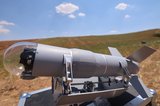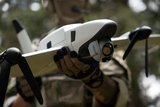US Air Force Predators achieve 500,000 Flight Hours
General Atomics Aeronautical Systems has announced that MQ-1 Predator aircraft delivered to the U.S. Air Force (USAF) have surpassed the 500,000 flight hour milestone, with 87 percent of those hours being flown in combat.
The milestone was achieved by aircraft P-143 on February 16 while it performed an armed reconnaissance mission in support of Operation Iraqi Freedom (OIF). This particular aircraft has flown over 330 combat missions in the two-and-a-half years it has been deployed.
"In July 1994 we delivered the first MQ-1 Predator, and next month we are scheduled to deliver the 200th Predator aircraft to our U.S. Air Force customer," said Thomas J. Cassidy, Jr., president, Aircraft Systems Group, General Atomics Aeronautical Systems, Inc.
"In less than two years, flight hours for all Predator A type aircraft have almost doubled and are now approaching 20,000 hours per month, with USAF MQ-1s flying nearly 85 percent of those hours.
Their 500,000 flight hours to date are a testimony to Predator A's legacy as the most combat-proven UAS ever produced, providing persistent armed reconnaissance and battlefield support to ground forces in the Balkans, Afghanistan, Iraq, and other world trouble spots."
"Members of the Air Force Material Command and GA-ASI have worked aggressively to deliver the Predator weapon system and the recent milestone is a result of a good partnership," said Col. Christopher Chambliss, 432nd Wing and 432nd Air Expeditionary Wing commander.
"The [Predator] program's success has been a testament to outstanding teamwork and American ingenuity and innovation, fueled by a desire to not settle for anything less than delivering the most reliable weapons systems to members of our armed forces when called upon to achieve national security objectives."
A growth evolution of the proven GNAT system, Predator A performs over-the-horizon, long-endurance, medium-altitude surveillance, reconnaissance, and weapons delivery and has an endurance of 40 hours.
Featuring common avionics and mechanical systems, Predator A is equipped with a satellite data link system; an Electro-Optical/Infrared (EO/IR)-stabilized gimbal containing color and infrared video cameras, plus laser designation, laser spotting, and laser range-finding capabilities; as well as laser-guided Hellfire missiles.
A Lynx Synthetic Aperture Radar (SAR) is also deployed and operational on some Predator A series aircraft. Predator As are currently operational with the U.S. Air Force, U.S. Navy, Italian Air Force, and the U.S. Army (I-GNAT ER/Sky Warrior Alpha).
More from Uncrewed Vehicles
-
![What's next for the Pentagon after the Replicator programme?]()
What's next for the Pentagon after the Replicator programme?
Although the Replicator initiative has made several accomplishments, there are still multiple gaps to plug across the US Department of Defense (DoD) and its services.
-
![Cummings Aerospace showcases Hellhound loitering munition designed for US Army’s LASSO programme (video)]()
Cummings Aerospace showcases Hellhound loitering munition designed for US Army’s LASSO programme (video)
Cummings Aerospace presented its turbojet-powered Hellhound loitering munition at SOF Week 2025, offering a man-portable solution aligned with the US Army’s LASSO requirements.
-
![SOF Week 2025: PDW unveils attritable FPV drone for SOF operations at scale]()
SOF Week 2025: PDW unveils attritable FPV drone for SOF operations at scale
PDW has revealed its Attritable Multirotor First Person View drone at SOF Week 2025, offering special operations forces a low-cost, rapidly deployable platform for strike and ISR missions, inspired by battlefield lessons from Ukraine.
-
![SOF Week 2025: Teledyne FLIR white paper provides guidance on reusable loitering munitions]()
SOF Week 2025: Teledyne FLIR white paper provides guidance on reusable loitering munitions
Teledyne FLIR is highlighting the emerging requirements for 'recoverable and re-usable' loitering munitions across the contemporary operating environment during this week’s SOF Week conference in Tampa, Florida.
-
![SOF Week 2025: Kraken Technology group debuts K3 Scout USV in North America]()
SOF Week 2025: Kraken Technology group debuts K3 Scout USV in North America
High-performance maritime industry player Kraken Technology Group, based in the UK, has used the SOF Week conference in Tampa, Florida this week to debut its K3 Scout uncrewed surface vessel (USV) to the North American market.
-
![Palladyne AI and Red Cat to demonstrate capabilities for autonomous drone swarms to the US military]()
Palladyne AI and Red Cat to demonstrate capabilities for autonomous drone swarms to the US military
Red Cat and Palladyne AI recently conducted a cross-platform collaborative flight involving three diverse heterogeneous drones.

























